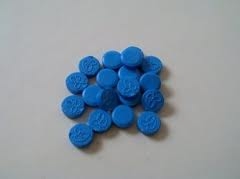The rising popularity of a synthetic drug in Colombia’s most elite club scene is indicative of a global trend, in which demand for heroin and cocaine is dropping and the use of manufactured stimulants is going up.
Semana reports that 2CB — a a stimulant and hallucinogenic drug first made popular in Europe, producing effects similar to MDMA — is becoming the new designer drug of choice in Colombian capital Bogota. The drug, which comes in either pill or powder form, sells for about 130,000 pesos (about $71) a gram, according to the news magazine. A kilo of the drug can sell for as much as 80 million pesos (about $43,750), bringing in much higher profits for Bogota-based drug dealers than cocaine, which is worth 2.5 million pesos (about $1,366).
Models, beauty queens, and even a few politicians have popularized the drug at Bogota’s exclusive night clubs, the magazine adds.
2CB was first produced in 1974 by Alexander Shulgin, the US chemist who popularized MDMA. It was temporarily sold in the US as a legal substitute for Ecstacy pills, but is now outlawed in that country. The United Nations lists 2CB as a Schedule II substance, meaning its distribution faces legal restrictions across the globe, but is not as stringently controlled as Schedule I drugs like cocaine, opium, and cannabis.
According to Semana, the synthetic drug was first produced by an entrepreneur known as alias “Alejo” in Colombia’s second-largest city, Medellin. But the local drug mafia, the Oficina de Envigado, drove him out. Alejo then attempted to set up a 2CB production center in Colombia’s third-largest city, Cali, but again was forced to leave by the local mob. He arrived in Bogota in 2010 and managed to build up his drug trafficking network until he was selling between five to eight kilos of 2CB a week.
Semana reports that Alejo was then kidnapped by a notorious Cali-based crime family, the Urdinolas, and was forced to reveal his production formula for the synthetic drug. The Urdinolas — who once worked for the extinct Norte del Valle Cartel and another Cali-based gang, the Machos — now control the 2CB business in Bogota, according to the magazine.
InSight Crime Analysis
The increased availability of 2CB in Colombia falls into a larger trend across the region, in which synthetic drugs are becoming more in demand. The United Nations 2012 World Drug report found that even as global cocaine and opium production has fallen significantly in the past five years, these gains have been offset by rising synthetic drug production, such as Ecstasy-like drugs like 2CB, and other drugs specifically manufactured in order to avoid international controls on certain chemicals, and thus be sold as “legal highs.” These include synthetic opioids, which is displacing heroin use, and synthetic cannabinoids which mimic marijuana, and new chemically engineered substances sold as bath salts or plant food. The report notes rising levels in the use of synthetic drugs among South American youth, and states that one synthetic drug, ketamine, is now reportedly available in countries like Argentina, El Salvador, Peru, and Uruguay.
The apparent rise of 2CB points to the declining popularity of the drugs that have traditionally drawn the most attention from law enforcement, a phenomenon that is not exclusive to Latin America. The US Senate has identified prescription pill abuse as one of the biggest health and security problems now facing the US. This has in turn raised questions over whether organized criminal groups in Latin America could begin trafficking in prescription pills, in order to compensate for the declining market for cocaine in the US. There have already been some allegations that such “pharma cartels” exist in Mexico.

